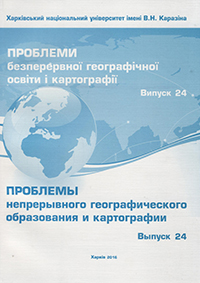The integrative potential of local geographical researches of the school students
Abstract
The article analyzes the experience of integrated researches on a geographical basis in Poltava Regional Centre of Tourism and Local Lore of the School Students for the period 2011-2015. The author believes that the integration of geography with other branches of science has a positive effect on the development of students’ key competencies. The article gives specific examples how geography can be combined with ecology, geology, zoology and history in the students’ researches as there is insufficient appropriate ethodological support in Ukraine. The first example describes the hydroecological study of small rivers combining geographical and ecological aspects. The attention is focused on the benefits of the methods which due to the speed, simplicity and effectiveness is productive for the research of regional rivers. In the second example a new direction for geographical research in Ukraine – biogeomorphology has been presented. The third example illustrates the approaches to recreational geography for developing excursion routes of the historical themes. The author emphasizes that all the examples have common features. They are effective holistic researches. This is confirmed by data on student participation in various conferences and competitions. In all integrated researches geographic component is clearly visible. Also in each case, integrated researches are important for the upbringing of students. Each of these aspects should be taken into account when choosing a research topic.
Downloads
References
2. Klepko, S.F. (2007). Konspekty` z filosofiyi osvity` [Conspectus of the philosophy of education]. Poltava: POIPPO, 420.
3. Kolbovskij, E.Ju. (2004). Izuchaem malye reki [We study small rivers]. Jaroslavl’: Akademija razvitija: Akademija Holding, 224.
4. Kouni, M. (1998). Kot po imeni Sabrina [A Tomcat Called Sabrina]. – Moskva: Armada, 416.
5. Navchal`ni programy` i prakty`chni zanyattya fakul`taty`vnyh kursiv «Yuny`j geograf-krayeznavecz`», «Osnovy` ekologiyi ta pry`rodokory`stuvannya» (2015) [Educational programs and practical studies of optional courses «Young geographer, local historian», «Fundamentals of Ecology and Nature Management»]. Ivano-Frankivs`k: IFOIPPO, 141.
6. Pokolodna, M.M. (2012). Rekreacijna geografiya: navch. posib. [Recreational geography: tutorial]. Xarkiv: XNAMG, 275.
7. Bondarchuk, D.O., Bondarchuk, O.S., Kolod`ko, N.I. etc. (2015). Programy` z pozashkil`noyi osvity`: tury`sts`ko-krayeznavchy`j napryam (vy`pusk 1) [Programs for extracurricular education: tourist and local lore direction (issue 1)]. Ky`yiv, 134.
8. Topuzov, O.M., Samojlenko, V.M., Vishnikina, L.P. (2012). Zagal`na metody`ka navchannya geografiyi: pidruchny`k [General methods of Geography teaching: textbook]. Ky`yiv: DNVP «Kartografiya», 512.
9. Butler, D.R. (1995). Zoogeomorphology. Animals as geomorphic agents. – Cambridge: University Press, 231.





